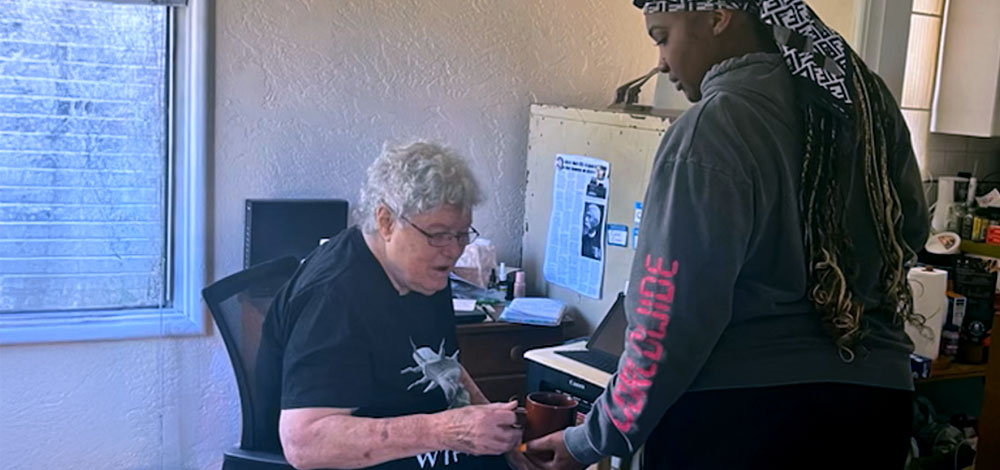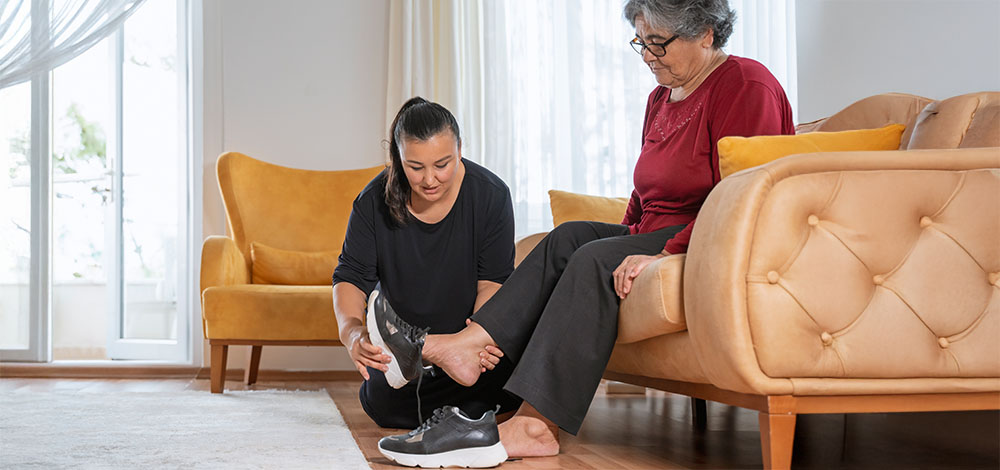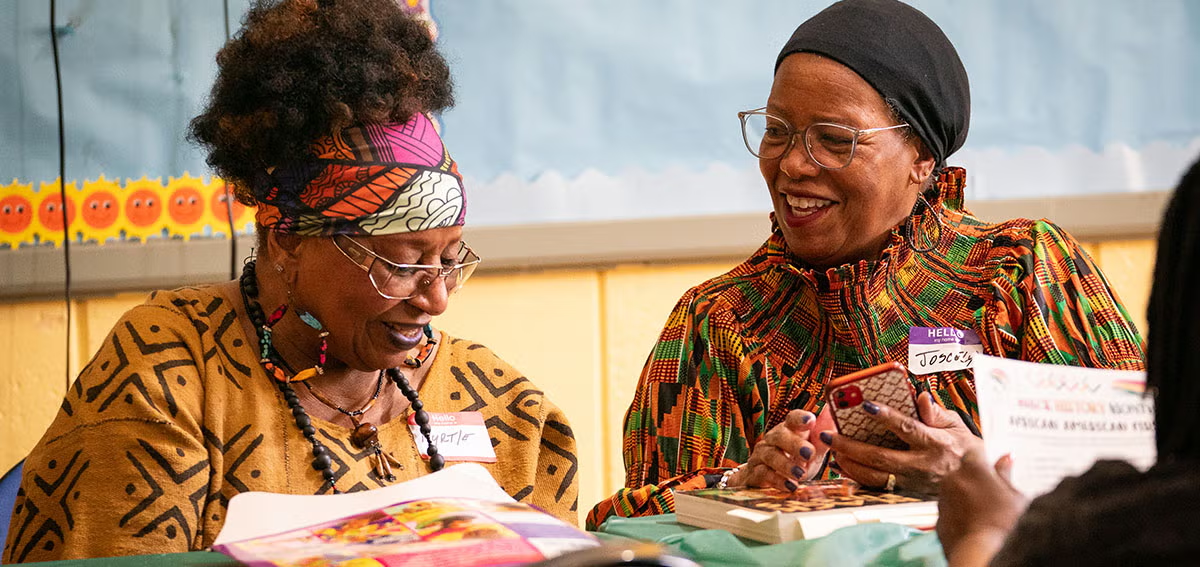
When I first met Chris in my palliative care clinic, he wasn’t sure why he needed to see me.
Bald, with deep-set brown eyes and a tattoo of his mother’s face wrapped around his forearm, Chris was midway through his fourth line of chemotherapy for stage IV colon cancer. Three other combinations of medications hadn’t stopped the growth of his cancer, but they had set his fingers and feet ablaze with nerve pain and stripped him of his ability to taste.
During our first appointment, we talked around, rather than about, his disease. His wry sense of humor stitched together the otherwise disparate parts of our conversation — his obsession with March Madness, his critique of a new crime novel, and his career in accounting, which ended when he was diagnosed at age 45. Sweat dotted his forehead as he read aloud the lists of medications he took and the movies he wanted to see, both detailed in his journal. He clenched his fists and grimaced during bouts of abdominal pain, shifting his slight body in his wheelchair. Eventually he admitted that he wasn’t sure what palliative care is or why he needed it.
Chris qualified for palliative care simply because he was living with — and visibly suffering from — a serious illness. Although a growing number of studies demonstrate that patients like Chris enjoy an improved quality of life (and in some cases live longer) when they receive palliative care along with standard cancer treatments, Chris was among the 71% of American adults who haven’t heard of palliative care. Chris’s brother, who accompanied him to our appointment, told me he had insisted that his oncologist refer Chris to my clinic. “I looked at my brother and thought he had zero quality of life, and when I read about palliative care I wondered why Chris hadn’t already been getting this service,” he said, tapping his pen on a notepad filled with questions he and Chris had written in preparation for our appointment. I nodded, recalling that despite his brother’s advocacy and research, Chris’s oncologist had emailed me to say that he wasn’t sure why Chris needed palliative care since “hospice is a long way off still.” Like many physicians and patients, Chris’s oncologist did not understand palliative care or how and when it can help people with serious illness.
Why Palliative Care?
Helping my patients and colleagues understand what palliative care is — and what it isn’t — is a common and necessary part of my job. While Chris’s brother and his oncologist had heard of palliative care, each had a different understanding of its general purpose and its specific role in Chris’s care. Some, like Chris’s oncologist, mistakenly equate palliative care with hospice, or with care in the final hours of life, which leads to patients getting palliative care far too late. Others incorrectly assume that patients must choose between palliative care and life-sustaining, disease-focused treatments. Contrary to these commonly held beliefs, patients should receive palliative care services at any stage of illness, and in conjunction with chemotherapy, dialysis, and other forms of life-prolonging treatment.
I believe that palliative care is about empowering patients caught in circumstances that can feel defeating. It is about both articulation and action. Life with a serious illness is a foreign landscape, one fraught with new physical, social, and existential realities and choices — many of which remain unacknowledged because of the fear and anxiety that society and the medical establishment have yoked to the concepts of mortality and suffering.
Despite this very human fear and anxiety, most people do want to talk with their doctors about serious illness. A recent CHCF survey of California adults found that about 9 in 10 respondents reported that if they had a serious illness they would want as much information as possible about what they should expect now and in the future. Eighty-two percent said that if they develop a serious illness, they want to discuss with their doctor their wishes for medical treatment toward the end of life. And yet 78% of survey respondents living with a serious illness have not been asked by a physician about these treatment wishes.
Helping my patients and colleagues understand what palliative care is — and what it isn’t — is a common and necessary part of my job.
—Sunita Puri, MD
It might seem intuitive that we should be talking with our patients about how to live well with a devastating illness. Yet although we physicians learn a dizzying amount of standardized information in medical school and residency, exposure to palliative care remains uneven. We learn to seek the help of cardiologists when a patient’s heart condition merits their expertise or procedural skill. We learn to call kidney specialists when patients meet criteria for dialysis. Yet the threshold to refer patients to palliative care specialists is often based on subjective, faulty perceptions about which patients would benefit from our services. Indeed, physician attitudes toward palliative care — rather than patients’ need for this subspecialty care — can profoundly affect whether people receive it early enough to benefit them. These misconceptions are reinforced by late and poorly explained referrals.
The Sooner, the Better
Several medical organizations have developed guidelines to help physicians recognize when they should consult palliative care specialists. The American Society for Clinical Oncology recommends that all patients with advanced cancer receive dedicated palliative care services in conjunction with active treatment. The American Heart Association issued a policy statement highlighting the importance of referring patients with advanced heart failure or debilitating stroke to palliative care specialists as soon as possible. But adherence to these guidelines remains elusive.
Only when I worked directly with a palliative care physician at the tail end of medical school did I finally understand how to treat the physical suffering of very sick patients and to ask about their hopes and wishes.
—Sunita Puri, MD
In order to empower physicians to understand what palliative care is and how it can assist the seriously ill, we must standardize exposure to palliative care in medical school and residency training. Lectures won’t suffice, just as conversations about cardiology are no substitute for the educational value of caring for a patient with heart disease.
Only when I worked directly with a palliative care physician at the tail end of medical school did I finally understand how to treat the physical suffering of very sick patients and to ask about their hopes and wishes. During that clinical rotation, a patient with metastatic breast cancer asked me to share my thoughts on her prognosis. I squirmed, searching for words I hadn’t been taught. I needed to experience the discomfort of my lack of expertise to fully appreciate the expertise of the palliative care team. Had palliative care been modeled for me throughout my training as an essential part of treatment for patients living with a serious illness, I might have been able to meet the needs of the many seriously ill patients I cared for during my residency.
Waiting Until “Next Time”
Sometimes the transformative power of palliative care can best be understood in its absence.
I saw Chris twice more before he died. He told me that the pain medications I’d prescribed helped him sleep through the night for the first time in many months. We talked about the list of books he hoped to read, now that he could lie in bed more comfortably. He told me he wanted to talk to me about what he might expect and plan for in the coming months. We agreed to discuss them next time, in about two weeks.
There wouldn’t be a next time. I saw him again the following week in the intensive care unit, after he suffered an overwhelming infection following another round of chemotherapy. Bound to a ventilator and a dialysis machine, he lay in a hospital bed adorned with a blue balloon emblazoned with the words “Get well soon!” I stood next to his brother as he cried and told me that Chris had written a list of questions about whether to continue with chemotherapy and what his other options might be. “He told me he thought the end might be near, and he just wanted to try and be at home for that, but he didn’t know how to make that happen, and neither did I,” his brother said, his head in his hands. Chris died the next day in the hospital, his body consumed by cancer and complications of chemotherapy.
Even though Chris had been sick for 18 months, I only knew him for a few weeks before he died. That evening, I imagined how Chris’s life might have been different if we’d met earlier. What questions might he have written in his journal? Might he have moved through the world with more ease if we’d managed his pain and fatigue sooner? Might he have forgone this last round of chemotherapy and enjoyed some quality time with his family if we had the opportunity to discuss hospice? Would his brother have found more peace had Chris died at home?
I returned home and added Chris’s first name to a list I keep in my own journal — patients who might have written the endings of their stories differently if only they had been empowered to do so. I regretted the choices Chris didn’t realize he could make, the list of questions I would never answer. I sat on my couch for a while, looking back at the names of other patients, hoping the time will come when I never have to add another.
Authors & Contributors

Sunita Puri
Sunita Puri, MD, is the author of That Good Night: Life and Medicine in the Eleventh Hour. She is the medical director of palliative medicine and supportive care at the Keck Hospital and Norris Cancer Center of the University of Southern California in Los Angeles. Her writing has appeared in the New York Times, Los Angeles Times, Slate, and the Journal of the American Medical Association.
She graduated from Yale University, attended Oxford University as a Rhodes scholar, completed medical school and residency training in internal medicine at UCSF, and went through fellowship training in hospice and palliative medicine at Stanford University.




